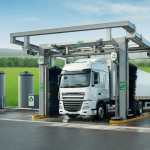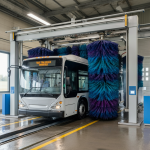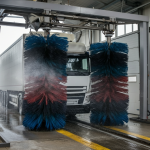Introduction
The Trump administration’s tariffs, imposed on imported goods like steel, aluminum, and a range of products from countries including China, were intended to protect domestic industries and reduce trade deficits. Despite these goals, the ripple effects of these tariffs have been far-reaching, influencing industries well beyond manufacturing and agriculture. For the trucking industry, these tariffs have created new challenges, altered freight dynamics, and forced companies to rethink their operations.
This article will explore how these tariffs have impacted trucking companies, affected freight rates, and prompted adaptations within the industry. Using data and insights from credible sources, we aim to shed light on the complex relationship between trade policies and the trucking business.
Impact on Trucking Companies
One of the most significant effects of the Trump-era tariffs on the trucking industry has been the increase in operational costs. Tariffs levied on steel and aluminum imports, in particular, have raised the prices of raw materials. This increase directly impacts industries like construction and manufacturing, which heavily rely on these materials. For trucking companies, the implications include both direct and indirect cost hikes.
Higher Truck Production Costs
Manufacturing trucks and trailers has become more expensive due to the higher prices of steel and aluminum. Reports from the American Trucking Associations (ATA) highlight that the increased cost of these essential materials has driven up the price of new vehicles. For trucking companies needing to expand or replace fleets, this represents a significant financial burden.
Increased Fuel and Maintenance Costs
The tariffs have also contributed to higher costs for replacement parts and equipment. Many replacement parts are either imported directly or manufactured using imported materials subject to tariffs. These increased costs add to the long list of operational expenses, from fuel to regular truck maintenance.
Burden on Small and Medium-Sized Carriers
Smaller trucking companies, which operate on tighter margins than larger carriers, are feeling the pinch the most. While larger companies may have the financial flexibility to absorb increased costs or negotiate long-term contracts with suppliers, smaller players often bear the full brunt of rising expenses.
Effect on Freight Rates
Freight rates are another area where the tariffs have left their mark, though the impact has been complex and varied across different regions and industries.
Increased Costs but Limited Rate Adjustments
While trucking companies are experiencing higher operational costs, freight rates have not uniformly risen to offset these expenses. According to data from the Bureau of Transportation Statistics (BTS), freight rates did see an initial rise after the tariffs were enacted, largely due to increased demand for domestic goods. However, this trend did not sustain uniformly due to market competition and fluctuating trade volumes.
For many trucking companies, the disconnect between rising costs and relatively stable freight rates has squeezed profit margins. Freight brokers also face challenges, as they must balance the needs of shippers looking for competitive rates with the financial realities of carriers operating at higher costs.
Decline in Freight Volume
Another significant consequence of the tariffs has been the reduction in overall freight volume for certain commodities. With tariffs discouraging imports, key industries like automotive manufacturing and agriculture have scaled back production, resulting in fewer goods needing to be transported. This decline in freight volume has exacerbated the pressure on carriers, particularly those specialized in affected sectors.
Challenges and Adaptations
The trucking industry’s challenges extend beyond cost increases. Adapting to the evolving trade landscape has required creativity and resilience.
Supply Chain Re-Evaluation
Trucking companies have found themselves at the mercy of shifting supply chains. Many businesses have reconfigured their sourcing strategies, opting for domestic suppliers or alternative international sources to avoid tariffs. This has led to shifts in transportation routes and delivery schedules.
For example, companies importing goods from countries outside the tariff zones have rerouted shipments to ports and logistics hubs that were not traditionally part of their supply networks. Trucking companies have had to adapt to these changes, often requiring investment in new infrastructure and logistics planning.
Diversifying Client Portfolios
To mitigate risks, many trucking companies have diversified their client portfolios and sought opportunities in industries less affected by tariffs. For instance, companies traditionally serving manufacturing clients might explore the e-commerce sector, where demand remains strong.
Leveraging Technology
Some carriers are turning to technology to offset the impact of tariffs. Tools such as route optimization software and predictive analytics help improve operational efficiency, allowing trucking companies to minimize costs through smarter planning.
The Road Ahead for the Trucking Industry
The Trump administration’s tariffs have had a lasting and multifaceted impact on the trucking industry. While the aim of these tariffs was to strengthen domestic manufacturing and protect jobs, the unintended consequences for adjacent sectors like trucking highlight the interconnected nature of the global supply chain.
Moving forward, several potential developments could shape the trucking industry:
- Shift Toward Domestic Manufacturing: If tariffs continue to discourage imports, businesses may invest more in domestic manufacturing. This could lead to increased demand for transportation services within the U.S.
- Changes in Trade Agreements: New trade policies or adjustments to existing tariffs could alter the landscape once again, presenting new challenges or opportunities.
- Technological Advancements: Trucking companies that invest in digital transformation and automation will likely be better positioned to adapt to future policy shifts and market changes.
For trucking companies, freight brokers, and industry analysts, staying informed and adaptable will be crucial. By leveraging industry insights, aligning strategies with shifting market dynamics, and investing in innovative solutions, the trucking industry can continue to drive forward despite the challenges posed by trade policies.




